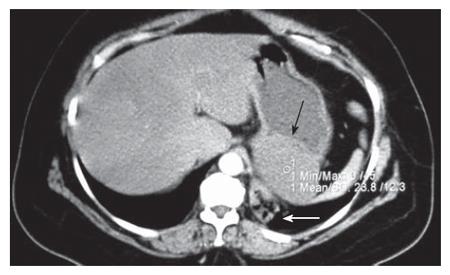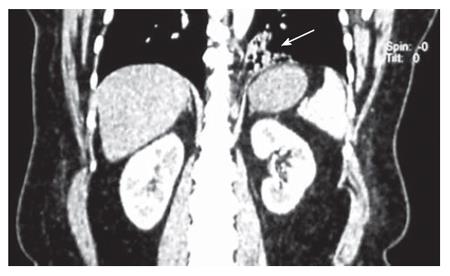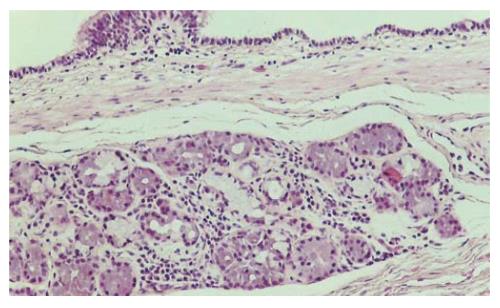Published online Feb 28, 2007. doi: 10.3748/wjg.v13.i8.1279
Revised: December 3, 2006
Accepted: January 31, 2007
Published online: February 28, 2007
Gastrointestinal duplication is a congenital rare disease entity. Gastric duplication cysts seem to appear even more rarely. Herein, two duplications cysts of the stomach in a 46 year-old female patient are presented. Abdominal computed tomography demonstrated a cystic lesion attached to the posterior aspect of the gastric fundus, while upper gastrointestinal endoscopy was negative. An exploratory laparotomy revealed a non-communicating cyst and a smaller similar cyst embedded in the gastrosplenic ligament. Excision of both cysts along with the spleen was performed and pathology reported two smooth muscle coated cysts with a pseudostratified ciliated epithelial lining (respiratory type).
- Citation: Theodosopoulos T, Marinis A, Karapanos K, Vassilikostas G, Dafnios N, Samanides L, Carνounis Ε. Foregut duplication cysts of the stomach with respiratory epithelium. World J Gastroenterol 2007; 13(8): 1279-1281
- URL: https://www.wjgnet.com/1007-9327/full/v13/i8/1279.htm
- DOI: https://dx.doi.org/10.3748/wjg.v13.i8.1279
Gastrointestinal duplications are rare and even more exceptional are those occurring in the stomach. As a general definition, a gastrointestinal duplication is a spherical hollow structure with a smooth muscle coat, lined by a mucous membrane and attached to any part of the gastrointestinal (GI) tract from the base of the tongue to the anus[1]. These malformations are believed to be congenital and are formed before differentiation of the lining epithelium and, therefore, are named for the organs with which they are associated[2]. Foregut duplications may or may not communicate with the GI tract and usually are diagnosed in a younger age; in adults non-specific symptoms delay diagnosis, which is established during surgical exploration[3]. Herein, two gastric duplication cysts with respiratory epithelium are reported.
A 46-year-old female patient was admitted to our Surgical Department from another medical center, where the patient was evaluated for an episode of loss of consciousness. Past medical history, present status and physical examination were non disease-specific. Diagnostic workup included an abdominal computed tomography (CT) which demonstrated a cystic lesion measuring 6 cm × 6 cm × 7 cm attached to the posterior wall of the gastric fundus, was well circumscribed and had no contrast enhancement (Figure 1). Interestingly CT coronary sections revealed a pulmonary sequestration in the basal segment of the left lower lobe (Figure 2). Moreover, upper GI endoscopy showed a bulging deformation of the gastric fundus by an extrinsic mass, without any mucosal abnormalities. An exploratory laparotomy was performed and revealed two cystic lesions; the first was attached to the fundus of the stomach and the second was embedded within the gastrosplenic ligament, close to the spleen. Therefore, intact excision of both cysts and splenectomy were carried out. Postoperative course was uneventful and the patient has been asymptomatic since then.
Pathologic examination of the surgical specimens reported a large cyst, measuring 8 cm × 5.5 cm in diameter and 0.3 cm thick and a smaller cyst (removed from the gastrosplenic ligament), measuring 3 cm in diameter and 0.2 cm thick. Both consisted of a smooth muscular wall, were lined by a pseudostratified, ciliated and columnar (respiratory type) epithelium and contained a clear, gelatinous fluid. Sub-epithelium seromucous glands were microscopically identified (Figure 3), a histologic appearance reminiscent of bronchial wall; however no cartilage was present.
Gastric duplications account for between 3% and 20% of gastrointestinal duplications[2,4,5] and occur twice as frequent in females as in males. Controversy exists over the embryological origin of these anomalies. Duplications of the stomach are usually single, less than 12 cm in diameter and located on the greater curvature or on the posterior or anterior gastric wall[2]. Wieczorek et al[6] reported that gastric duplications can be tubular or cystic; the cystic type does not communicate with the gastric lumen (about 80% of gastric duplication cysts[7]). The first case report of a gastric duplication was published in 1911 by Wendel[8] and approximately 150 cases have been reported since then[2].
Due to their position and mass effect, gastric duplications cysts are usually diagnosed in a younger age. However, in adults diagnosis may be difficult. A wide range of symptoms and signs have been reported and vary from asymptomatic to non disease-specific presentations, e.g. vague abdominal complaints, nausea, vomiting, epigastric fullness, weight loss, anemia, dysphagia, dyspepsia, etc. Vomiting usually occurs due to partial or complete gastric outlet obstruction, while even more emergent cases have been reported such as pancreatitis[9], hemoptysis[10] and gastrointestinal hemorrhage[11]. In our case, the female patient presented with loss of consciousness due to dehydration occurring as a result of excessive vomiting and concomitant anemia. Associated pathologic conditions including pulmonary sequestration[12], multicystic kidney[13] and neoplasias[14] have been reported. The presence of respiratory type mucosa and seromucinous glands along with the presence of pulmonary sequestration in the lower lobe of the ipsilateral lung in our case supports the theory of embryologic origin from supernumerary foregut buds.
Foregut duplications cysts of the stomach are usually incidentally diagnosed. Although upper gastrointestinal series demonstrate external pressure on the stomach, preoperative workup mainly includes abdominal ultrasonography and computed tomography scans, as well as endoscopic ultrasonography and magnetic resonance imaging[15,16].
Due to malignant transformation and the report of gastric cancer arising in duplications of the stomach[17] , surgical excision is considered to be the best treatment. Complete resection of the cyst is the ideal technique achieved with both open and laparoscopic[18] approaches. Unsuccessful approaches including percutaneous or endoscopic aspiration of cystic fluid have been reported[19], but are associated with complications, such as fistula formation and hemorrhage. When the recommended complete excision is not possible, converting both stomachs into one using a stapling device[20] or performing a segmental gastrectomy[21] are the possible alternatives.
In conclusion, foregut duplication cysts of the stomach are rare entities diagnosed incidentally and usually intraoperatively in adults and should be treated surgically by complete resection.
S- Editor Liu Y L- Editor Zhu LH E- Editor Ma WH
| 1. | Glaser C, Kuzinkovas V, Maurer C, Glättli A, Mouton WG, Baer HU. A large duplication cyst of the stomach in an adult presenting as pancreatic pseudocyst. Dig Surg. 1998;15:703-706. [RCA] [PubMed] [DOI] [Full Text] [Cited by in Crossref: 12] [Cited by in RCA: 20] [Article Influence: 0.8] [Reference Citation Analysis (0)] |
| 2. | Cunningham SC, Hansel DE, Fishman EK, Cameron JL. Foregut duplication cyst of the stomach. J Gastrointest Surg. 2006;10:620-621. [RCA] [PubMed] [DOI] [Full Text] [Cited by in Crossref: 21] [Cited by in RCA: 23] [Article Influence: 1.2] [Reference Citation Analysis (0)] |
| 3. | Perek A, Perek S, Kapan M, Göksoy E. Gastric duplication cyst. Dig Surg. 2000;17:634-636. [RCA] [PubMed] [DOI] [Full Text] [Cited by in Crossref: 31] [Cited by in RCA: 33] [Article Influence: 1.4] [Reference Citation Analysis (0)] |
| 4. | Pruksapong C, Donovan RJ, Pinit A, Heldrich FJ. Gastric duplication. J Pediatr Surg. 1979;14:83-85. [RCA] [PubMed] [DOI] [Full Text] [Cited by in Crossref: 56] [Cited by in RCA: 59] [Article Influence: 1.3] [Reference Citation Analysis (0)] |
| 5. | Chawla A, Gadaleta D, Kenigsberg K, Kahn E, Markowitz J. Erosion through the posterior gastric wall by a pancreatic pseudocyst secondary to gastric duplication. J Pediatr Gastroenterol Nutr. 1991;13:115-118. [RCA] [PubMed] [DOI] [Full Text] [Cited by in Crossref: 2] [Cited by in RCA: 4] [Article Influence: 0.1] [Reference Citation Analysis (0)] |
| 6. | Wieczorek RL, Seidman I, Ranson JH, Ruoff M. Congenital duplication of the stomach: case report and review of the English literature. Am J Gastroenterol. 1984;79:597-602. [PubMed] |
| 7. | Spivak H, Pascal RR, Wood WC, Hunter JG. Enteric duplication presenting as cystic tumors of the pancreas. Surgery. 1997;121:597-600. [RCA] [PubMed] [DOI] [Full Text] [Cited by in Crossref: 17] [Cited by in RCA: 17] [Article Influence: 0.6] [Reference Citation Analysis (0)] |
| 8. | Wendel W. Beschreibung eines operativ entfernten congenitalen Nebenmagens. Arch Klin Chir. 1911;96:895-898. |
| 9. | Katz W, Annessa G, Read RC. Gastric duplication with pancreatic communication. Presenting as pancreatitis. Minn Med. 1967;50:1175-1179. [PubMed] |
| 10. | Menon P, Rao KL, Saxena AK. Duplication cyst of the stomach presenting as hemoptysis. Eur J Pediatr Surg. 2004;14:429-431. [RCA] [PubMed] [DOI] [Full Text] [Cited by in Crossref: 12] [Cited by in RCA: 14] [Article Influence: 0.7] [Reference Citation Analysis (0)] |
| 11. | Stephen TC, Bendon RW, Nagaraj HS, Sachdeva R. Antral duplication cyst: a cause of hypergastrinemia, recurrent peptic ulceration, and hemorrhage. J Pediatr Gastroenterol Nutr. 1998;26:216-218. [RCA] [PubMed] [DOI] [Full Text] [Cited by in Crossref: 17] [Cited by in RCA: 17] [Article Influence: 0.6] [Reference Citation Analysis (0)] |
| 12. | Mahour GH, Woolley MM, Payne VC. Association of pulmonary sequestration and duplication of the stomach. Int Surg. 1971;56:224-227. [PubMed] |
| 13. | Liebert PS. Gastric duplication and multicystic kidney associated with gonadal dysgenesis. Clin Pediatr (Phila). 1970;9:60-62. [RCA] [PubMed] [DOI] [Full Text] [Cited by in Crossref: 4] [Cited by in RCA: 5] [Article Influence: 0.1] [Reference Citation Analysis (0)] |
| 14. | Mayo HW, Mckee EE, Anderson RM. Carcinoma arising in reduplication of the stomach (gastrogenous cyst): a case report. Ann Surg. 1955;141:550-555. [RCA] [PubMed] [DOI] [Full Text] [Cited by in Crossref: 41] [Cited by in RCA: 44] [Article Influence: 2.0] [Reference Citation Analysis (0)] |
| 15. | Tanaka M, Akahoshi K, Chijiiwa Y, Sasaki I, Nawata H. Diagnostic value of endoscopic ultrasonography in an unusual case of gastric cyst. Am J Gastroenterol. 1995;90:662-663. [PubMed] |
| 16. | Takahara T, Torigoe T, Haga H, Yoshida H, Takeshima S, Sano S, Ishii Y, Furuya T, Nakamura E, Ishikawa M. Gastric duplication cyst: evaluation by endoscopic ultrasonography and magnetic resonance imaging. J Gastroenterol. 1996;31:420-424. [RCA] [PubMed] [DOI] [Full Text] [Cited by in Crossref: 30] [Cited by in RCA: 35] [Article Influence: 1.2] [Reference Citation Analysis (0)] |
| 17. | Kuraoka K, Nakayama H, Kagawa T, Ichikawa T, Yasui W. Adenocarcinoma arising from a gastric duplication cyst with invasion to the stomach: a case report with literature review. J Clin Pathol. 2004;57:428-431. [RCA] [PubMed] [DOI] [Full Text] [Cited by in Crossref: 97] [Cited by in RCA: 88] [Article Influence: 4.2] [Reference Citation Analysis (0)] |
| 18. | Machado MA, Santos VR, Martino RB, Makdissi F, Canedo L, Bacchella T, Machado MC. Laparoscopic resection of gastric duplication: successful treatment of a rare entity. Surg Laparosc Endosc Percutan Tech. 2003;13:268-270. [RCA] [PubMed] [DOI] [Full Text] [Cited by in Crossref: 18] [Cited by in RCA: 16] [Article Influence: 0.7] [Reference Citation Analysis (0)] |
| 19. | Ferrari AP, Van Dam J, Carr-Locke DL. Endoscopic needle aspiration of a gastric duplication cyst. Endoscopy. 1995;27:270-272. [RCA] [PubMed] [DOI] [Full Text] [Cited by in Crossref: 15] [Cited by in RCA: 15] [Article Influence: 0.5] [Reference Citation Analysis (0)] |
| 20. | Izzidien al-Samarrai AY, Crankson SJ, Sadiq S. The use of mechanical sutures in the treatment of gastric duplications. Z Kinderchir. 1989;44:186-187. [PubMed] |
| 21. | Holcomb GW, Gheissari A, O'Neill JA, Shorter NA, Bishop HC. Surgical management of alimentary tract duplications. Ann Surg. 1989;209:167-174. [RCA] [PubMed] [DOI] [Full Text] [Cited by in Crossref: 218] [Cited by in RCA: 199] [Article Influence: 5.5] [Reference Citation Analysis (0)] |











